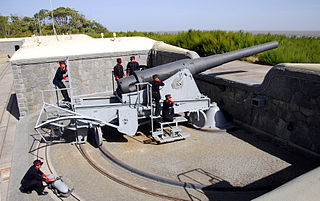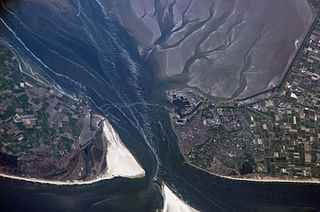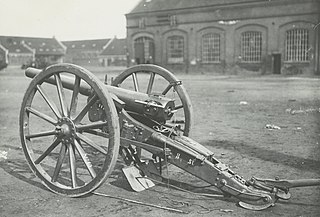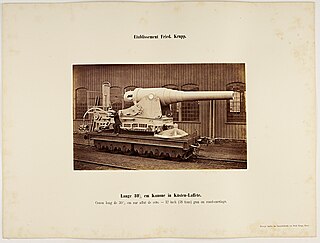
Willemsoord is a large former naval base of the Royal Netherlands Navy in Den Helder. It is now connected to the city center of Den Helder, and focuses on entertainment and tourism.

The 24 cm K L/35 was a German naval gun developed in the years before World War I that armed ships of the Imperial German Navy, Argentine Navy and the Austro-Hungarian Navy. Guns removed from ships of the Imperial German Navy were modified to perform Coastal Artillery and Railway Artillery roles and saw service in both world wars.

The Heiligerlee-class monitors were a group of five ironclad monitors built for the Royal Netherlands Navy in the late 1860s.

HNLMS Heiligerlee, formerly known as Panter, was a Heiligerlee-class monitor built in England for the Royal Netherlands Navy in the 1860s. Among the new ships built for the Dutch navy Heiligerlee was the first true monitor: a ship with shallow draught, only a few (heavy) guns and decent armor. These characteristics made her very suitable to operate way inland in the Dutch delta.

The Djambi class was a class of steam corvettes of the Royal Netherlands Navy. The class comprised Djambi, Zoutman, Willem, Leeuwarden, Metalen Kruis and Curaçao. Later two ships of a supposedly 'slightly revised' type were built, the Zilveren Kruis-class corvettes.

The Groningen class was a class of steam corvettes of the Royal Netherlands Navy. The class comprised Groningen, Citadel van Antwerpen and Vice-Admiraal Koopman

The Medusa class was a class of two steam corvettes with auxiliary power of the Royal Netherlands Navy. The class comprised Medusa, the first Dutch warship with screw propulsion, and Prinses Amelia.

HNLMS Adolf van Nassau was a unique ship built for the Royal Netherlands Navy.

The Ever class was a class of 14 flat-iron gunboats of the Royal Netherlands Navy.

HNLMS Matador was a monitor built in the late 1870s.

Nieuwediep was a canal and harbor. In about 1800 the major naval base Willemsoord was constructed west of it, soon followed by a major commercial port. After World War II, Nieuwe Haven Naval Base was built on reclaimed land east of the Nieuwediep, and the Nieuwdiep's source and mouth were dammed off.

Koopvaarders Lock in Den Helder, Netherlands connects the Noordhollandsch Kanaal to the Nieuwediep. There were 4 locks at Nieuwediep carrying this name.

The RML 16 cm No. 3, or Getrokken kanon van 16 cm No. 3 was a rifled muzzle loading gun. It was a Dutch attempt to cheaply provide rifled ordnance to its navy.

The RML 16 cm No. 1, or Getrokken kanon van 16 cm No. 1 was a rifled muzzle loading gun. It was the first Dutch rifled gun which had been designed as such.

The 8 cm staal is a 19th century Dutch field gun. It replaced the 8 cm A. bronze. The steel barrel and carriage were made by Krupp in Essen, Germany. In turn the 8 cm staal would be replaced by the Krupp 7.5 cm Model 1903. The '8 staal' was hastily brought back into service on the eve of World War II.

The Anna Paulowna class was a class of steam frigates of the Royal Netherlands Navy. Only Anna Paulowna was completed, parts of Van Galen were used to build the steam corvette Zilveren Kruis.

Fort Harssens is a former fortress and museum in Den Helder North-Holland. It protected the naval base Willemsoord. The fortress had 4 heavy naval guns placed in two armored cupolas. Nowadays, the maritime traffic control center sits on top of the fortrress.

The 30.5 cm Mantel Ring Kanone L/25 was a 30.5 cm 25 caliber long Krupp Mantel Ring Kanone. It was a further development of the earlier 30.5 cm MRK L/22. It came in different models. The Chinese Navy used the gun on board the Dingyuan-class ironclads. The Dutch Army used one of these models as coastal artillery. Due to changes in the interior configuration of the gun, this was basically a shorter version of the 30.5 cm MRK L/35.

Fort IJmuiden is a former fort, now heritage site and event location in IJmuiden North-Holland. It protected the entrance to the North Sea Canal. The fort was originally located north of the canal, but by the construction of a new branch, it became an island. Most of the old fort and some World War II additions have been preserved. A rare armored emplacement that protected five heavy guns, is still in place.

























